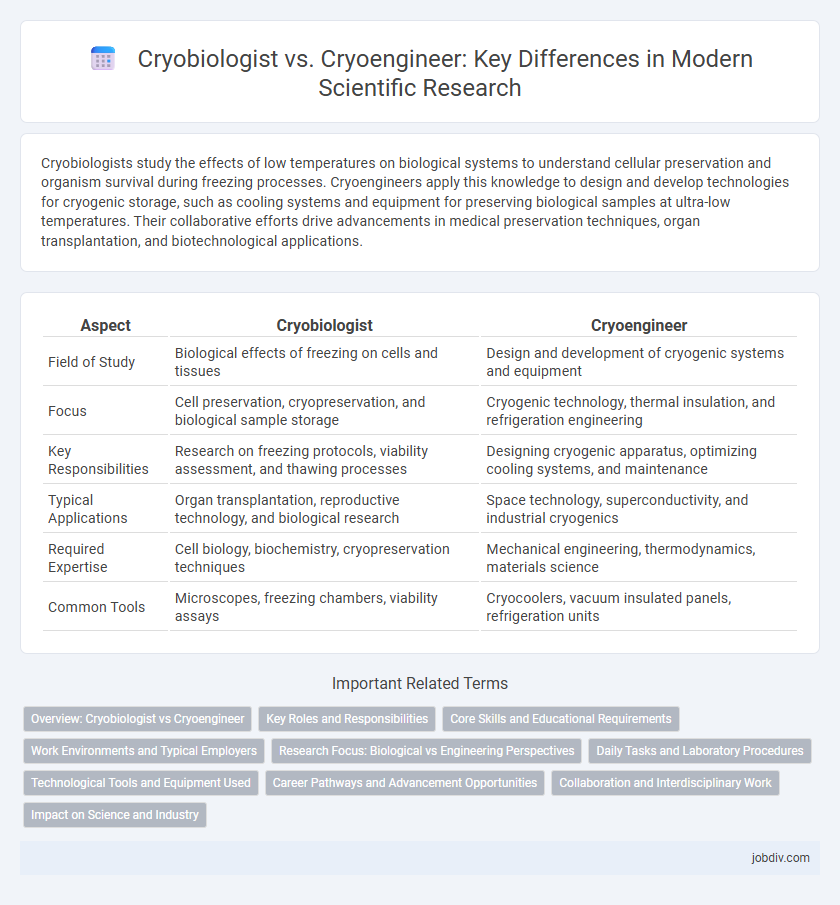Cryobiologists study the effects of low temperatures on biological systems to understand cellular preservation and organism survival during freezing processes. Cryoengineers apply this knowledge to design and develop technologies for cryogenic storage, such as cooling systems and equipment for preserving biological samples at ultra-low temperatures. Their collaborative efforts drive advancements in medical preservation techniques, organ transplantation, and biotechnological applications.
Table of Comparison
| Aspect | Cryobiologist | Cryoengineer |
|---|---|---|
| Field of Study | Biological effects of freezing on cells and tissues | Design and development of cryogenic systems and equipment |
| Focus | Cell preservation, cryopreservation, and biological sample storage | Cryogenic technology, thermal insulation, and refrigeration engineering |
| Key Responsibilities | Research on freezing protocols, viability assessment, and thawing processes | Designing cryogenic apparatus, optimizing cooling systems, and maintenance |
| Typical Applications | Organ transplantation, reproductive technology, and biological research | Space technology, superconductivity, and industrial cryogenics |
| Required Expertise | Cell biology, biochemistry, cryopreservation techniques | Mechanical engineering, thermodynamics, materials science |
| Common Tools | Microscopes, freezing chambers, viability assays | Cryocoolers, vacuum insulated panels, refrigeration units |
Overview: Cryobiologist vs Cryoengineer
Cryobiologists study the effects of low temperatures on biological systems, focusing on cellular preservation, cryopreservation of tissues, and understanding freeze-thaw damage mechanisms. Cryoengineers design and develop cryogenic systems and technologies to enable precise temperature control, storage, and transportation of biological samples under ultra-low temperature conditions. Both fields collaborate closely, with cryobiologists providing biological insights while cryoengineers create the necessary infrastructure for practical cryogenic applications.
Key Roles and Responsibilities
Cryobiologists investigate the effects of low temperatures on biological systems, focusing on cellular preservation, cryopreservation techniques, and understanding freeze-thaw damage mechanisms. Cryoengineers design and develop cryogenic equipment and systems, such as ultra-low temperature freezers, cryostats, and cooling technology, to support scientific research and industrial applications. Both roles are essential in advancing cryotechnology, with cryobiologists emphasizing biological impact and cryoengineers concentrating on technical innovation.
Core Skills and Educational Requirements
Cryobiologists specialize in studying the effects of low temperatures on biological systems, requiring a strong foundation in biology, biochemistry, and molecular biology, typically obtained through advanced degrees such as a master's or Ph.D. in biology or biophysics. Cryoengineers focus on designing and developing cryogenic equipment and systems, demanding expertise in mechanical engineering, thermodynamics, and materials science, often achieved through a bachelor's or master's degree in engineering disciplines. Both roles require proficiency in cryogenic technologies, but cryobiologists emphasize experimental research and biological processes, while cryoengineers prioritize practical applications and the creation of cryogenic devices.
Work Environments and Typical Employers
Cryobiologists primarily work in research laboratories, universities, and pharmaceutical companies, focusing on the biological effects of low temperatures on cells and tissues. Cryoengineers are typically employed by aerospace firms, medical device manufacturers, and cryogenic equipment companies, designing and optimizing systems for cryogenic temperatures. Both roles frequently collaborate with government research institutions and specialized cryo-storage facilities.
Research Focus: Biological vs Engineering Perspectives
Cryobiologists concentrate on understanding the biological processes and cellular responses to low temperatures, emphasizing cryopreservation, ice formation, and the effects on living tissues for medical and biological research. Cryoengineers focus on designing and developing cryogenic systems and technologies, optimizing thermal management, and controlling cryogenic environments to enhance practical applications such as storage, transportation, and industrial processes. The research distinction lies in the biological analysis of cryoinjury and cell viability by cryobiologists versus the engineering innovation and system integration by cryoengineers.
Daily Tasks and Laboratory Procedures
Cryobiologists primarily conduct research on the effects of low temperatures on biological systems, focusing on cellular preservation, cryoprotectant toxicity, and thawing processes through detailed microscopic and biochemical assays. Cryoengineers design and maintain cryogenic equipment, optimize cooling protocols, and implement thermal management systems to ensure precise temperature control and minimize thermal fluctuations during experiments. Daily tasks for cryobiologists involve sample preparation and viability testing, whereas cryoengineers handle equipment calibration, system troubleshooting, and procedural automation.
Technological Tools and Equipment Used
Cryobiologists primarily utilize advanced microscopes, spectrophotometers, and cryostats to study cellular responses to low temperatures and to preserve biological samples with precision. Cryoengineers focus on designing and operating cryogenic systems, including refrigeration units, vacuum insulated panels, and automated temperature control devices essential for maintaining ultra-low environments. Both disciplines integrate thermal imaging cameras and data acquisition software to monitor and optimize cryogenic processes, enhancing the efficiency and accuracy of their respective research and applications.
Career Pathways and Advancement Opportunities
Cryobiologists specialize in studying the effects of low temperatures on biological systems, leading to career opportunities in academic research, medical institutions, and biotechnology firms focused on cryopreservation and organ preservation. Cryoengineers concentrate on designing and developing cryogenic equipment and technologies, advancing their careers in aerospace, refrigeration, and advanced manufacturing industries. Career advancement for cryobiologists often involves transitioning into principal investigator roles or clinical applications, while cryoengineers may progress into senior engineering positions or project management within cryogenic technology development.
Collaboration and Interdisciplinary Work
Cryobiologists and cryoengineers collaborate closely to advance the science and technology of low-temperature biology, combining expertise in cellular preservation and mechanical system design. This interdisciplinary synergy enables the optimization of cryopreservation methods and the development of advanced cryogenic equipment. Integrating biological insights with engineering innovations drives breakthroughs in areas such as organ preservation and cryogenic storage technologies.
Impact on Science and Industry
Cryobiologists study the effects of low temperatures on living organisms, advancing scientific understanding of cellular preservation and organ cryopreservation techniques that have revolutionized medical transplantation and reproductive technologies. Cryoengineers design and develop cryogenic systems and equipment, enabling scalable industrial applications such as liquefied gas production, space exploration, and superconducting technologies. The collaborative impact of cryobiology and cryoengineering accelerates innovation in biomedical research and cryogenic infrastructure, driving breakthroughs in healthcare and industrial processes.
Cryobiologist vs Cryoengineer Infographic

 jobdiv.com
jobdiv.com